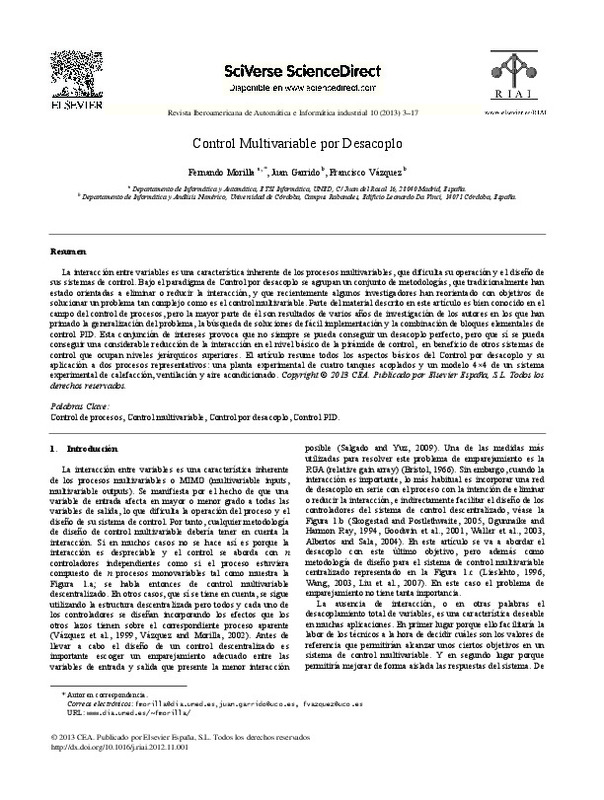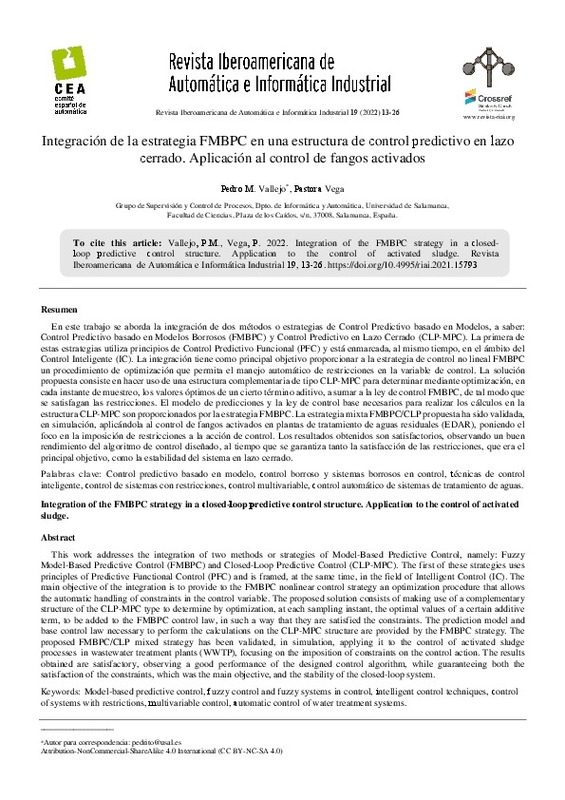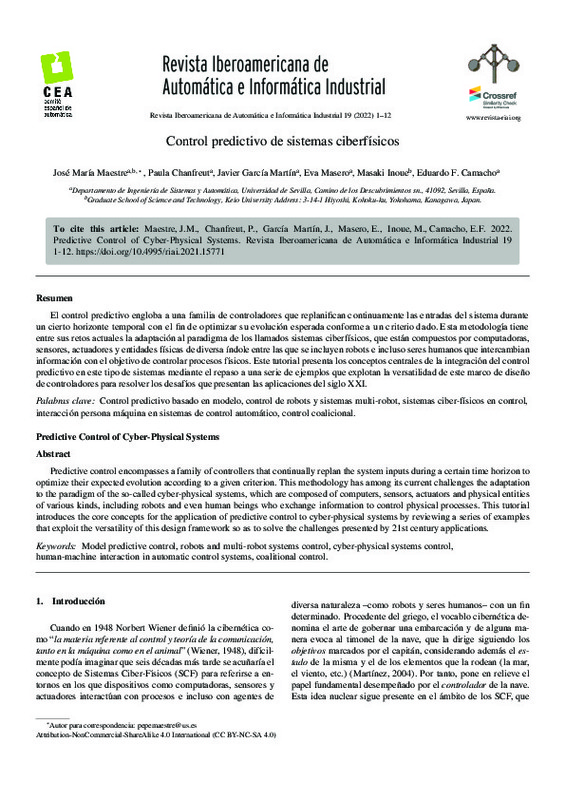JavaScript is disabled for your browser. Some features of this site may not work without it.
Buscar en RiuNet
Listar
Mi cuenta
Estadísticas
Ayuda RiuNet
Admin. UPV
Control Multivariable por Desacoplo
Mostrar el registro sencillo del ítem
Ficheros en el ítem
| dc.contributor.author | Morilla, Fernando
|
es_ES |
| dc.contributor.author | Garrido, Juan
|
es_ES |
| dc.contributor.author | Vázquez, Francisco
|
es_ES |
| dc.date.accessioned | 2020-05-22T08:13:59Z | |
| dc.date.available | 2020-05-22T08:13:59Z | |
| dc.date.issued | 2013-01-13 | |
| dc.identifier.issn | 1697-7912 | |
| dc.identifier.uri | http://hdl.handle.net/10251/144123 | |
| dc.description.abstract | [ES] La interacción entre variables es una característica inherente de los procesos multivariables, que dificulta su operación y el diseño de sus sistemas de control. Bajo el paradigma de Control por desacoplo se agrupan un conjunto de metodologías, que tradicionalmente han estado orientadas a eliminar o reducir la interacción, y que recientemente algunos investigadores han reorientado con objetivos de solucionar un problema tan complejo como es el control multivariable. Parte del material descrito en este artículo es bien conocido en el campo del control de procesos, pero la mayor parte de él son resultados de varios años de investigación de los autores en los que han primado la generalización del problema, la búsqueda de soluciones de fácil implementación y la combinación de bloques elementales de control PID. Esta conjunción de intereses provoca que no siempre se pueda conseguir un desacoplo perfecto, pero que sí se pueda conseguir una considerable reducción de la interacción en el nivel básico de la pirámide de control, en beneficio de otros sistemas de control que ocupan niveles jerárquicos superiores. El artículo resume todos los aspectos básicos del Control por desacoplo y su aplicación a dos procesos representativos: una planta experimental de cuatro tanques acoplados y un modelo 4×4 de un sistema experimental de calefacción, ventilación y aire acondicionado. | es_ES |
| dc.description.abstract | [EN] The interaction between variables is inherent in multivariable processes and this fact may complicate their operation and control system design. Under the paradigm of decoupling control, several methodologies that traditionally have been addressed to cancel or reduce the interactions are gathered. Recently, this approach has been reoriented by several researchers with the aim to solve such a complex problem as the multivariable control. Parts of the material in this work are well known in the process control field; however, most of them are results obtained by the authors after several years of research giving priority to the problem generalization and practical issues like easiness of implementation and utilization of PID controllers as elementary blocks. This combination of interests makes difficult to obtain perfect decoupling in all cases; although it is possible to achieve an important interaction reduction at the basic level of the control pyramid in such a way that other control systems at higher hierarchical levels benefit of this fact. This article summarizes the main aspects of decoupling control and presents its application to two illustrative examples: an experimental quadruple tank process and a 4×4 model of a heat, ventilation and air conditioning system. | es_ES |
| dc.description.sponsorship | Ministerio de Educación y Ciencia (DPI 2007-62052). Junta de Andalucía ( P10-TEP-6056) | es_ES |
| dc.language | Español | es_ES |
| dc.publisher | Universitat Politècnica de València | es_ES |
| dc.relation.ispartof | Revista Iberoamericana de Automática e Informática industrial | es_ES |
| dc.rights | Reconocimiento - No comercial - Sin obra derivada (by-nc-nd) | es_ES |
| dc.subject | Process control | es_ES |
| dc.subject | Multivariable control | es_ES |
| dc.subject | Decoupling control | es_ES |
| dc.subject | PID control | es_ES |
| dc.subject | Control de procesos | es_ES |
| dc.subject | Control multivariable | es_ES |
| dc.subject | Control por desacoplo | es_ES |
| dc.subject | Control PID | es_ES |
| dc.title | Control Multivariable por Desacoplo | es_ES |
| dc.title.alternative | Multivariable Control by Decoupling | es_ES |
| dc.type | Artículo | es_ES |
| dc.identifier.doi | 10.1016/j.riai.2012.11.001 | |
| dc.relation.projectID | info:eu-repo/grantAgreement/MEC//DPI2007-62052/ES/CONTROL CENTRALIZADO CON CONTROLADORES PID/ | es_ES |
| dc.relation.projectID | info:eu-repo/grantAgreement/Junta de Andalucía//P10-TEP-6056/ | es_ES |
| dc.relation.projectID | info:eu-repo/grantAgreement/MEC//AP2006-0104/ES/AP2006-0104/ | es_ES |
| dc.rights.accessRights | Abierto | es_ES |
| dc.description.bibliographicCitation | Morilla, F.; Garrido, J.; Vázquez, F. (2013). Control Multivariable por Desacoplo. Revista Iberoamericana de Automática e Informática industrial. 10(1):3-17. https://doi.org/10.1016/j.riai.2012.11.001 | es_ES |
| dc.description.accrualMethod | OJS | es_ES |
| dc.relation.publisherversion | https://doi.org/10.1016/j.riai.2012.11.001 | es_ES |
| dc.description.upvformatpinicio | 3 | es_ES |
| dc.description.upvformatpfin | 17 | es_ES |
| dc.type.version | info:eu-repo/semantics/publishedVersion | es_ES |
| dc.description.volume | 10 | es_ES |
| dc.description.issue | 1 | es_ES |
| dc.identifier.eissn | 1697-7920 | |
| dc.relation.pasarela | OJS\9553 | es_ES |
| dc.contributor.funder | Ministerio de Educación y Ciencia | es_ES |
| dc.contributor.funder | Junta de Andalucía | es_ES |
| dc.description.references | Åström, K. J., & Hägglund, T. (1984). Automatic tuning of simple regulators with specifications on phase and amplitude margins. Automatica, 20(5), 645-651. doi:10.1016/0005-1098(84)90014-1 | es_ES |
| dc.description.references | Bristol, E. (1966). On a new measure of interaction for multivariable process control. IEEE Transactions on Automatic Control, 11(1), 133-134. doi:10.1109/tac.1966.1098266 | es_ES |
| dc.description.references | Cai, W.-J., Ni, W., He, M.-J., & Ni, C.-Y. (2008). Normalized Decoupling A New Approach for MIMO Process Control System Design. Industrial & Engineering Chemistry Research, 47(19), 7347-7356. doi:10.1021/ie8006165 | es_ES |
| dc.description.references | Gagnon, E., Pomerleau, A., & Desbiens, A. (1998). Simplified, ideal or inverted decoupling? ISA Transactions, 37(4), 265-276. doi:10.1016/s0019-0578(98)00023-8 | es_ES |
| dc.description.references | Garrido, J. 2012. Diseño de sistemas de control multivariable por desacoplo con controladores PID. Doctoral dissertation, UNED. | es_ES |
| dc.description.references | Garrido, J., Vázquez, F., Morilla, F. 2010. Centralized Inverted Decoupling for TITO Processes. Proceedings of the 15th IEEE International Conference on Emerging Technologies and Factory Automation. Bilbao, Spain. | es_ES |
| dc.description.references | Garrido, J., Vázquez, F., & Morilla, F. (2011). An extended approach of inverted decoupling. Journal of Process Control, 21(1), 55-68. doi:10.1016/j.jprocont.2010.10.004 | es_ES |
| dc.description.references | Garrido, J., Vázquez, F., & Morilla, F. (2012). Centralized multivariable control by simplified decoupling. Journal of Process Control, 22(6), 1044-1062. doi:10.1016/j.jprocont.2012.04.008 | es_ES |
| dc.description.references | Åström, K. J., & Hägglund, T. (2004). Revisiting the Ziegler–Nichols step response method for PID control. Journal of Process Control, 14(6), 635-650. doi:10.1016/j.jprocont.2004.01.002 | es_ES |
| dc.description.references | Ho, W. K., Hang, C. C., & Cao, L. S. (1995). Tuning of PID controllers based on gain and phase margin specifications. Automatica, 31(3), 497-502. doi:10.1016/0005-1098(94)00130-b | es_ES |
| dc.description.references | Johansson, K. H. (2000). The quadruple-tank process: a multivariable laboratory process with an adjustable zero. IEEE Transactions on Control Systems Technology, 8(3), 456-465. doi:10.1109/87.845876 | es_ES |
| dc.description.references | Lee, M., Lee, K., Kim, C., & Lee, J. (2004). Analytical design of multiloop PID controllers for desired closed-loop responses. AIChE Journal, 50(7), 1631-1635. doi:10.1002/aic.10166 | es_ES |
| dc.description.references | Lieslehto, J. 1996. MIMO controller design using SISO controller design methods. Proceeding of the 13th IFAC World Congress. San Francisco, USA. | es_ES |
| dc.description.references | Liu, T., Zhang, W., & Gao, F. (2007). Analytical decoupling control strategy using a unity feedback control structure for MIMO processes with time delays. Journal of Process Control, 17(2), 173-186. doi:10.1016/j.jprocont.2006.08.010 | es_ES |
| dc.description.references | Morilla, F., Dormido, S. 2000. Methodologies for the tuning of PID controllers in the frequency domain. PID’00 IFAC Workshop on Digital Control: Past, present and future of PID Control. Terrassa, Spain. | es_ES |
| dc.description.references | Nordfeldt, P., & Hägglund, T. (2006). Decoupler and PID controller design of TITO systems. Journal of Process Control, 16(9), 923-936. doi:10.1016/j.jprocont.2006.06.002 | es_ES |
| dc.description.references | Rivera, D. E., Morari, M., & Skogestad, S. (1986). Internal model control: PID controller design. Industrial & Engineering Chemistry Process Design and Development, 25(1), 252-265. doi:10.1021/i200032a041 | es_ES |
| dc.description.references | Salgado, M. E., & Yuz, J. I. (2009). Una medida de interacción multivariable en el dominio del tiempo y de la frecuencia. Revista Iberoamericana de Automática e Informática Industrial RIAI, 6(2), 17-25. doi:10.1016/s1697-7912(09)70089-5 | es_ES |
| dc.description.references | Shen, Y., Cai, W.-J., & Li, S. (2010). Normalized decoupling control for high-dimensional MIMO processes for application in room temperature control HVAC systems. Control Engineering Practice, 18(6), 652-664. doi:10.1016/j.conengprac.2010.03.006 | es_ES |
| dc.description.references | Wade, H. L. (1997). Inverted decoupling: a neglected technique. ISA Transactions, 36(1), 3-10. doi:10.1016/s0019-0578(97)00008-6 | es_ES |
| dc.description.references | Waller(Toijala), K. V. T. (1974). Decoupling in distillation. AIChE Journal, 20(3), 592-594. doi:10.1002/aic.690200321 | es_ES |
| dc.description.references | Waller, M., Waller, J. B., & Waller, K. V. (2003). Decoupling Revisited†. Industrial & Engineering Chemistry Research, 42(20), 4575-4577. doi:10.1021/ie020911c | es_ES |
| dc.description.references | Wang, Q.-G., Huang, B., & Guo, X. (2000). Auto-tuning of TITO decoupling controllers from step tests. ISA Transactions, 39(4), 407-418. doi:10.1016/s0019-0578(00)00028-8 | es_ES |
| dc.description.references | Wang, Q.-G., Zhang, Y., & Chiu, M.-S. (2002). Decoupling internal model control for multivariable systems with multiple time delays. Chemical Engineering Science, 57(1), 115-124. doi:10.1016/s0009-2509(01)00365-7 | es_ES |
| dc.description.references | Wang, Q.-G., Zhang, Y., & Chiu, M.-S. (2003). Non-interacting control design for multivariable industrial processes. Journal of Process Control, 13(3), 253-265. doi:10.1016/s0959-1524(02)00028-8 | es_ES |
| dc.description.references | Xiong, Q., Cai, W.-J., & He, M.-J. (2007). Equivalent transfer function method for PI/PID controller design of MIMO processes. Journal of Process Control, 17(8), 665-673. doi:10.1016/j.jprocont.2007.01.004 | es_ES |
| dc.description.references | Zhang, W., Lin, C., & Ou, L. (2006). Algebraic Solution toH2Control Problems. II. The Multivariable Decoupling Case. Industrial & Engineering Chemistry Research, 45(21), 7163-7176. doi:10.1021/ie0602310 | es_ES |











